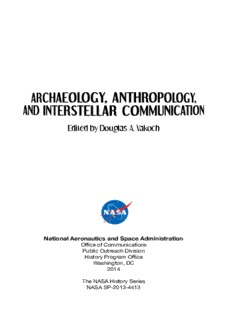
Archaeology, Anthropology, and Interstellar Communication - NASA PDF
Preview Archaeology, Anthropology, and Interstellar Communication - NASA
Edited by Douglas A. Vakoch National Aeronautics and Space Administration Office of Communications Public Outreach Division History Program Office Washington, DC 2014 The NASA History Series NASA SP-2013-4413 Library of Congress Cataloging-in-Publication Data Archaeology, anthropology, and interstellar communication / edited by Douglas A. Vakoch. p. cm. -- (The NASA history series) “SP-2013-4413.” 1. Life on other planets. 2. Extraterrestrial anthropology. 3. Interstellar communication. 4. Exobiology. 5. Archaeoastronomy. I. Vakoch, Douglas A. QB54.A74 2012 999--dc23 2011053528 s ok www.nasa.gov/ebo This publication is available as a free download at http://www.nasa.gov/ebooks. ISBN 978-1-62683-013-4 90000 9 781626 830134 To Chris Neller, for her ongoing support of the Search for Extraterrestrial Intelligence TABLE OF CONTENTS Acknowledgments ix List of Figures xi I. Introduction Reconstructing Distant Civilizations and Encountering Alien Cultures Douglas A. Vakoch xiii II. Historical Perspectives on SETI Chapter 1: SETI: The NASA Years John Billingham 1 Chapter 2: A Political History of NASA’s SETI Program Stephen J. Garber 23 Chapter 3: The Role of Anthropology in SETI A Historical View Steven J. Dick 49 III. Archaeological Analogues Chapter 4: A Tale of Two Analogues Learning at a Distance from the Ancient Greeks and Maya and the Problem of Deciphering Extraterrestrial Radio Transmissions Ben Finney and Jerry Bentley 65 Chapter 5: Beyond Linear B The Metasemiotic Challenge of Communication with Extraterrestrial Intelligence Richard Saint-Gelais 79 Chapter 6: Learning To Read Interstellar Message Decipherment from Archaeological and Anthropological Perspectives Kathryn E. Denning 95 v Archaeology, Anthropology, and Interstellar Communication Chapter 7: Inferring Intelligence Prehistoric and Extraterrestrial Paul K. Wason 113 IV. Anthropology, Culture, and Communication Chapter 8: Anthropology at a Distance SETI and the Production of Knowledge in the Encounter with an Extraterrestrial Other John W. Traphagan 131 Chapter 9: Contact Considerations A Cross-Cultural Perspective Douglas Raybeck 143 Chapter 10: Culture and Communication with Extraterrestrial Intelligence John W. Traphagan 161 Chapter 11: Speaking for Earth Projecting Cultural Values Across Deep Space and Time Albert A. Harrison 175 V. The Evolution and Embodiment of Extraterrestrials Chapter 12: The Evolution of Extraterrestrials The Evolutionary Synthesis and Estimates of the Prevalence of Intelligence Beyond Earth Douglas A. Vakoch 191 Chapter 13: Biocultural Prerequisites for the Development of Interstellar Communication Garry Chick 205 Chapter 14: Ethology, Ethnology, and Communication with Extraterrestrial Intelligence Dominique Lestel 229 vi Reconstructing Distant Civilizations and Encountering Alien Cultures Chapter 15: Constraints on Message Construction for Communication with Extraterrestrial Intelligence William H. Edmondson 237 VI. Epilogue Mirrors of Our Assumptions Lessons from an Arthritic Neanderthal Douglas A. Vakoch 251 About the Authors 255 NASA History Series 261 Index 279 vii ACKNOWLEDGMENTS To the authors of Archaeology, Anthropology, and Interstellar Communication, I especially appreciate the innovation and depth of the research they share here. They deserve special thanks for thoughtfully engaging one another’s ideas, as reflected in the numerous cross-references between chapters throughout the volume. Paul Duffield captures the essential themes of this conversation in his compelling cover art, and I am grateful for his creativity in translating these ideas into images, giving readers an overview of the contents before they even open the book. Over the past 15 years, many colleagues from the SETI Institute have shared with me their insights into the Search for Extraterrestrial Intelligence, as well as the ways we can best communicate this work to the broader public. I especially thank Molly Bentley, Anu Bhagat, James Brewster, Steve Brockbank, Edna DeVore, Frank Drake, Sophie Essen, Andrew Fraknoi, John Gertz, Gerry Harp, Jane Jordan, Ly Ly, Michelle Murray, Chris Munson, Chris Neller, Tom Pierson, Karen Randall, Jon Richards, Pierre Schwob, Seth Shostak, and Jill Tarter. I am grateful to John Billingham for his many years of friendship, generosity, and commitment to exploring the societal dimensions of astrobiology. We miss him, but his memory lives on. I warmly acknowledge the administration, faculty, staff, and students of the California Institute of Integral Studies (CIIS), especially for support from Joseph Subbiondo, Judie Wexler, and Tanya Wilkinson. Much of the work of editing this volume was made possible through a generous sabbatical leave from my other academic responsibilities at CIIS. In addition, I thank Harry and Joyce Letaw as well as Jamie Baswell for their intellectual and financial contributions to promoting the Search for Extraterrestrial Intelligence. Among the organizations that have fostered discussions on the topics in this volume, I especially want to recognize the International Academy of Astronautics (IAA), the American Anthropological Association (AAA), and the Society for Cross-Cultural Research (SCCR). Several of the chapters in this volume are elaborations of papers first presented at AAA annual conferences. For their openness to considering a new topic for the NASA History Series, I thank Steve Dick and Bill Barry. I am also grateful to them and to Steve Garber for leading such a thorough and helpful review process. I appreciate Yvette Smith for moving this volume into production so steadfastly and efficiently, and I thank Nadine Andreassen for her diligence in publicizing the book. On the production side, Kimberly Ball Smith and Mary Tonkinson care- fully copyedited the manuscript, and Heidi Blough created the index. In the Communications Support Services Center at NASA Headquarters, I ix Archaeology, Anthropology, and Interstellar Communication thank the entire team that brought this book to print. Mary Tonkinson and George Gonzalez proofread the layout, and Tun Hla handled the printing. Supervisors Christopher Yates, Barbara Bullock, Cindy Miller, and Michael Crnkovic oversaw the entire process. To my wife, Julie Bayless, I am grateful in more ways that I can or will share here. Thank you, forever. x
Description: